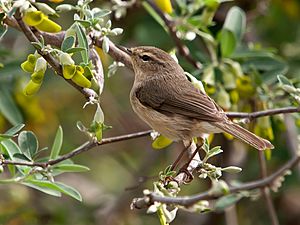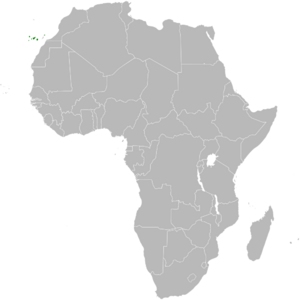Canary Islands chiffchaff facts for kids
Quick facts for kids Canary Islands chiffchaff |
|
|---|---|
 |
|
| On Gran Canaria, Canary Islands, Spain | |
| Conservation status | |
| Scientific classification | |
| Genus: |
Phylloscopus
|
| Species: |
canariensis
|
| Subspecies | |
|
|
 |
|
The Canary Islands chiffchaff (Phylloscopus canariensis) is a small bird that lives only on the Canary Islands in Spain. It is a type of leaf warbler, which are small, active birds.
Contents
About the Canary Islands Chiffchaff
This bird is special because it is found nowhere else in the world! It is a unique part of the Canary Islands' wildlife.
What is a Chiffchaff?
Chiffchaffs are small birds known for their simple, repeated songs. They often have dull colors, like greens, browns, and yellows. They are very active and constantly move through trees and bushes looking for insects.
Family Tree of the Chiffchaff
Long ago, the Canary Islands chiffchaff was thought to be just a type of the common chiffchaff. But now, scientists have studied it more closely. They found that it is different enough to be its own separate species. It is now called Phylloscopus canariensis.
Different Kinds of Canary Islands Chiffchaffs
There are two main groups, or subspecies, of the Canary Islands chiffchaff:
- Western Canary Islands chiffchaff (Phylloscopus canariensis canariensis): You can find this group on the western islands like El Hierro, La Palma, La Gomera, Tenerife, and Gran Canaria.
- Eastern Canary Islands chiffchaff (Phylloscopus canariensis exsul): This group lived on the eastern islands, mainly Lanzarote. Sadly, this subspecies is probably extinct. This means there are no more of them left alive.
What Does It Look Like?
The Canary Islands chiffchaff looks a lot like its relatives, the common chiffchaff and the Iberian chiffchaff. However, there are some small differences:
- It has a slightly longer beak.
- Its wings are a bit shorter.
- Its tail is longer.
- The feathers on its belly and chest are a brownish-buff color.
- Its back feathers are a darker brown than the common chiffchaff.
What Does It Sound Like?
Many of its calls sound similar to the common chiffchaff. But its song is different. It is not as steady or "metronomic" as the common chiffchaff's song. Instead, it is harsher, shorter, and more varied. The Canary Islands chiffchaff also sings faster.
Where Does It Live?
You can find the Canary Islands chiffchaff in many different places on the islands. It lives in coastal gardens and even in high-up mountain areas. However, it usually avoids very dry, semi-desert areas near the coast.
How Does It Live?
The Canary Islands chiffchaff is a very active bird. It moves quickly and often flicks its wings and wags its tail.
Breeding and Nests
From January to June, which is their breeding season, these birds are very protective of their space. They live alone or in pairs. Their nest is shaped like a ball with an opening on the side.
- In coastal areas, they build their nests close to the ground in bushes.
- In forests, especially in laurisilva (a type of forest with laurel trees), they build their nests higher up, sometimes over 8 meters (26 feet) off the ground.
- A female bird usually lays 2 to 5 eggs. Many pairs will have three sets of babies in one breeding season!
After Breeding
When it's not breeding season, usually in the autumn and winter, these birds become more social. They form small groups or flocks. By late July, they usually finish changing their old feathers for new ones.
What Do They Eat?
The Canary Islands chiffchaff loves to eat insects. It spends most of its time looking for food among the leaves of plants and trees. It searches from the ground all the way up to the tops of the trees. It can also hover in the air to catch insects, pick them off leaves, or catch them while flying.
Images for kids
See also
 In Spanish: Pájaro para niños
In Spanish: Pájaro para niños




